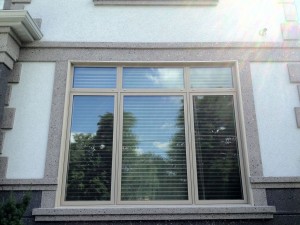
Windows are inherently a weak point in the building envelope in terms of its insulative properties. Wall assemblies, to the Ontario Building Code, requires it to be insulated to R-19. Compared that to windows, the minimum requirements for an Energy Star window is R3.2 for our region (Southern Ontario, Zone B). However, while windows can be a source of heat loss, they can also be a source of heat gain as well, which is bad in the summer, but advanteageous in the winter. Our choice involved a combination of strategies to take a balanced approach to the problem.
We looked at windows from various manufacturers, and compared the R-values of the windows. What we found was that triple pane windows in general offer a higher R-value compared to double panes, but at a price premium. To complicate matters, our design called for large casement windows, which when combined with the weight of the triple pane glass, caused us to look at fiberglass framed windows exclusively.
Fiberglass frames have several benefits. They are far stronger than vinyl frames, and would withstand the test of time much better in our case of triple pane casements, the largest of which would be 30″ wide by 60″ tall. Each of the casements weighed in excess of 100 pounds, and one can imagine the stress of the weight while the window is opened with little support. The other major benefit is that in differing temperature extremes, fiberglass expands and contracts at a rate very similar to glass, while vinyl expands and contracts much differently, giving the potential of an increased air infiltration compared to the ideal test environment of which the standardized testings are based.
When selecting coatings for the windows, we tuned it based on the exposures of the windows. For north, east, and west facing windows where the sun shines rarely on it, we selected windows that offered us the best R-value. For the south facing windows, however, we chose windows that had coatings that allowed for a higher solar gain heat coefficient (SGHC) for heating benefits in the winter, by giving up some R-value for the windows. We countered the effect of the gains in the summer by calculating sun angles and designing the overhangs above the windows to block sun in the summer, but at a lower sun angle in the winter, the sulight would enter the house.
Our Fibertec Windows offered an R-value of 7.7 for the fixed panes, and 5.5 for the operable casements, far exceeding the energy star requirements. The south facing windows offered an R-value of about R4 for the operables, but the SGHC was increased from 0.26 to 0.44 to allow for more heat gain in the winter. Our other reason for selecting Fibertec windows was for their hinge design, as it sat closer to the bottom of the frame for better support of the heavy triple pane casements. Their custom brickmould that are channel locked to the window also allowed for an easy installation that reduced on-site installation time. We estimated a total cost increase of about 25% from a traditional double pane vinyl windows.
CaGBC LEED for Homes – Points can be acheived in Energy and Atmosphere, either via the air leakage tests (EA 3.3) and the exceptional windows (EA 4.3), or exceptional energy performance (EA 1.2) via the ERS/HERS method.
